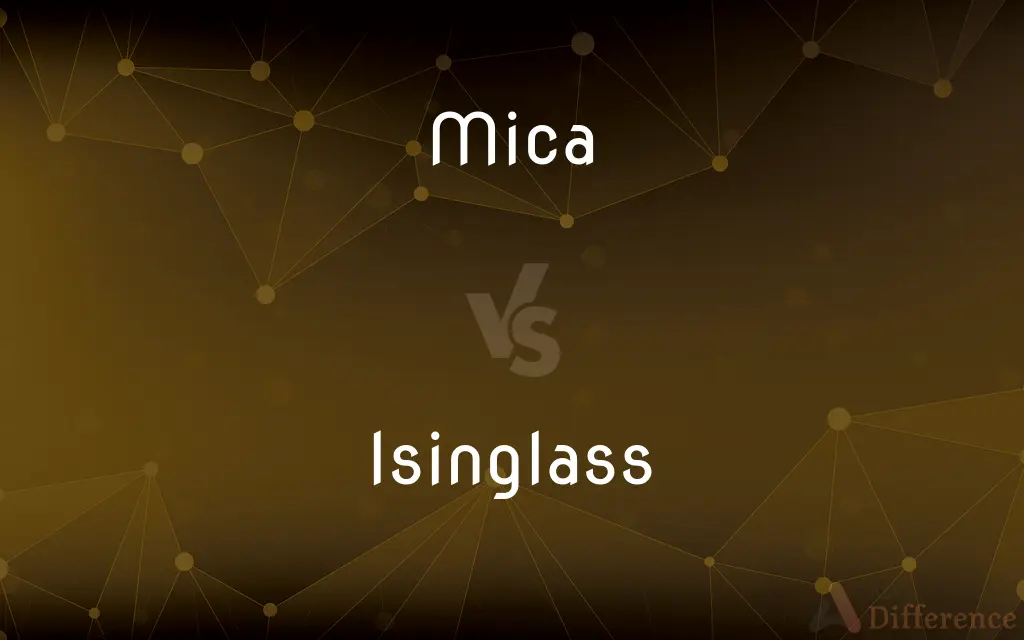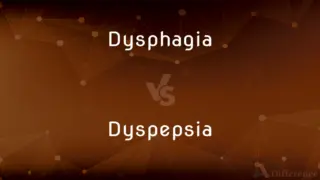Mica vs. Isinglass — What's the Difference?
By Tayyaba Rehman & Fiza Rafique — Updated on March 15, 2024
Mica refers to a group of silicate minerals known for their layered structure and electrical insulation properties, while isinglass is a form of gelatin obtained from fish, traditionally used in clarifying beverages and as an adhesive.

Difference Between Mica and Isinglass
Table of Contents
ADVERTISEMENT
Key Differences
Mica encompasses a variety of silicate minerals characterized by their perfect basal cleavage, allowing them to be split into thin, flexible sheets. These minerals are utilized in a wide range of industrial applications, including electrical insulators, heat-resistant materials, and additives in cosmetics for their shimmering appearance. On the other hand, isinglass historically refers to a specific type of gelatin derived from the swim bladders of certain fish, particularly sturgeon. It has been used in the clarification of beer and wine, making them clearer by removing suspended particles.
While mica's significance lies primarily in its physical and chemical properties, which make it valuable in industrial and cosmetic applications, isinglass plays a role in food and beverage production and historical adhesive formulations. Mica's resistance to heat, electricity, and chemical attack, along with its ability to be split into thin sheets, sets it apart from isinglass, which is prized for its gelatinous properties and ability to interact with organic compounds in solution.
Mica can be found in various geological environments worldwide and is mined for its numerous industrial applications. In contrast, isinglass production is more specialized, relying on the availability of suitable fish species and has been somewhat superseded by modern synthetic alternatives for many of its traditional uses.
Both mica and isinglass have historical significance, with mica being used in various cultures for its reflective properties and isinglass for its clarifying and adhesive qualities. However, the shift towards synthetic materials and changes in industrial practices have led to a decline in the traditional uses of isinglass, while mica continues to be relevant due to its unique physical properties.
Comparison Chart
Composition
Silicate minerals with a layered structure.
Gelatin derived from the swim bladders of fish.
ADVERTISEMENT
Primary Use
Industrial applications, cosmetics.
Clarification of beverages, adhesives.
Properties
Heat-resistant, electrical insulator, flexible.
Gelatinous, clarifying agent.
Occurrence
Found in various geological environments.
Obtained from certain fish species.
Modern Relevance
Continues to be widely used in industry.
Has seen a decline with synthetic alternatives.
Compare with Definitions
Mica
A mineral known for its ability to split into thin, flexible sheets.
Mica is used in electrical insulators due to its resistance to electricity.
Isinglass
Historically used as an adhesive in applications requiring clarity.
Isinglass was once used in the restoration of parchment.
Mica
Valued in high-temperature applications for its heat resistance.
Mica is a key component in thermal insulation materials.
Isinglass
A form of gelatin from fish swim bladders used in beverage clarification.
Isinglass is added to beer to make it clear and bright.
Mica
Utilized for its shimmering quality in cosmetics.
The eyeshadow's sparkle comes from the mica in its formulation.
Isinglass
Utilized in traditional recipes and medical preparations.
Isinglass was an ingredient in some old medicinal jellies.
Mica
Found in a variety of geological settings.
Large mica deposits are mined for industrial use.
Isinglass
Its use has declined due to synthetic alternatives.
Modern breweries often use synthetic agents instead of isinglass for clarification.
Mica
Plays a role in electronic and electrical devices.
Mica sheets are used in capacitors for their insulating properties.
Isinglass
Derived primarily from sturgeon and other fish.
The finest isinglass comes from sturgeon swim bladders.
Mica
Micas ( MY-kəz) are a group of minerals whose outstanding physical characteristic is that individual mica crystals can easily be split into extremely thin elastic plates. This characteristic is described as perfect basal cleavage.
Isinglass
Isinglass () is a substance obtained from the dried swim bladders of fish. It is a form of collagen used mainly for the clarification or fining of some beer and wine.
Mica
A shiny silicate mineral with a layered structure, found as minute scales in granite and other rocks, or as crystals. It is used as a thermal or electrical insulator.
Isinglass
A kind of gelatin obtained from fish, especially sturgeon, and used in making jellies, glue, etc. and for fining real ale.
Mica
Any of a group of chemically and physically related aluminum silicate minerals, common in igneous and metamorphic rocks, characteristically splitting into flexible sheets used in insulation and electrical equipment.
Isinglass
Mica or a similar material in thin transparent sheets.
Mica
(mineral) Any of a group of hydrous aluminosilicate minerals characterized by highly perfect cleavage, so that they readily separate into very thin leaves, more or less elastic.
Isinglass
A transparent, almost pure gelatin prepared from the swim bladder of the sturgeon and certain other fishes and used as an adhesive and a clarifying agent.
Mica
The name of a group of minerals characterized by highly perfect cleavage, so that they readily separate into very thin leaves, more or less elastic. They differ widely in composition, and vary in color from pale brown or yellow to green or black. The transparent forms are used in lanterns, the doors of stoves, etc., being popularly called isinglass. Formerly called also cat-silver, and glimmer.
Isinglass
Mica in thin, transparent sheets.
Mica
Any of various minerals consisting of hydrous silicates of aluminum or potassium etc. that crystallize in forms that allow perfect cleavage into very thin leaves; used as dielectrics because of their resistance to electricity
Isinglass
A form of gelatine obtained from the air bladder of the sturgeon and certain other fish, used as an adhesive and as a clarifying agent for wine and beer.
Isinglass
A thin, transparent sheet of mica (probably from its similarity to true isinglass).
Isinglass
A semitransparent, whitish, and very pure form of gelatin, chiefly prepared from the sounds or air bladders of various species of sturgeons (as the Acipenser huso) found in the rivers of Western Russia. It used for making jellies, as a clarifier, etc. Cheaper forms of gelatin are not unfrequently so called. Called also fish glue.
Isinglass
A popular name for mica, especially when in thin sheets.
Isinglass
Any of various minerals consisting of hydrous silicates of aluminum or potassium etc. that crystallize in forms that allow perfect cleavage into very thin leaves; used as dielectrics because of their resistance to electricity
Common Curiosities
How is isinglass made?
Isinglass is made from the dried swim bladders of certain fish, primarily sturgeon.
Why has the use of isinglass declined?
The use of isinglass has declined due to the development of synthetic clarifying agents and adhesives that are more consistent and widely available.
Is mica environmentally friendly?
The environmental impact of mica mining depends on the mining practices. Ethical sourcing and sustainable mining practices are important considerations.
What is mica used for?
Mica is used in electrical insulators, heat-resistant materials, and cosmetics, among other applications.
Are there different types of mica?
Yes, there are several types of mica, including muscovite, biotite, and phlogopite, each with unique properties and uses.
What makes mica unique among minerals?
Mica's unique properties include its perfect basal cleavage, allowing it to be split into thin, flexible sheets, and its resistance to heat and electricity.
How is isinglass applied in the clarification process?
Isinglass is added to beverages like beer and wine, where it binds with suspended particles, causing them to settle and resulting in a clearer product.
Can mica conduct electricity?
Mica is an excellent electrical insulator and does not conduct electricity, making it valuable in electrical applications.
Is isinglass still used in beer making?
Isinglass is used in some traditional brewing processes to clarify beer, but its use has declined with the availability of synthetic alternatives.
Can isinglass be used in vegetarian or vegan products?
Isinglass, derived from fish, is not suitable for vegetarian or vegan products, leading to the use of alternative clarifying agents in such products.
Can mica be found everywhere?
Mica is found in various geological environments around the world, but commercial mining operations are concentrated in areas with large, high-quality deposits.
Are there any modern alternatives to isinglass?
Modern alternatives to isinglass include synthetic clarifying agents in brewing and various synthetic adhesives in other applications.
How does mica contribute to the cosmetic industry?
Mica is used in the cosmetic industry for its shimmering effect, adding sparkle and luster to products like eyeshadows, lipsticks, and highlighters.
What are the ethical concerns associated with mica mining?
Ethical concerns in mica mining include child labor and unsafe working conditions in some regions. Efforts are being made to improve transparency and ethical sourcing.
What is the historical significance of isinglass?
Historically, isinglass was valued for its clarity and strength as an adhesive, as well as its use in clarifying beers and wines.
Share Your Discovery

Previous Comparison
Dysphagia vs. Dyspepsia
Next Comparison
Lieutenant vs. LeftenantAuthor Spotlight
Written by
Tayyaba RehmanTayyaba Rehman is a distinguished writer, currently serving as a primary contributor to askdifference.com. As a researcher in semantics and etymology, Tayyaba's passion for the complexity of languages and their distinctions has found a perfect home on the platform. Tayyaba delves into the intricacies of language, distinguishing between commonly confused words and phrases, thereby providing clarity for readers worldwide.
Co-written by
Fiza RafiqueFiza Rafique is a skilled content writer at AskDifference.com, where she meticulously refines and enhances written pieces. Drawing from her vast editorial expertise, Fiza ensures clarity, accuracy, and precision in every article. Passionate about language, she continually seeks to elevate the quality of content for readers worldwide.















































